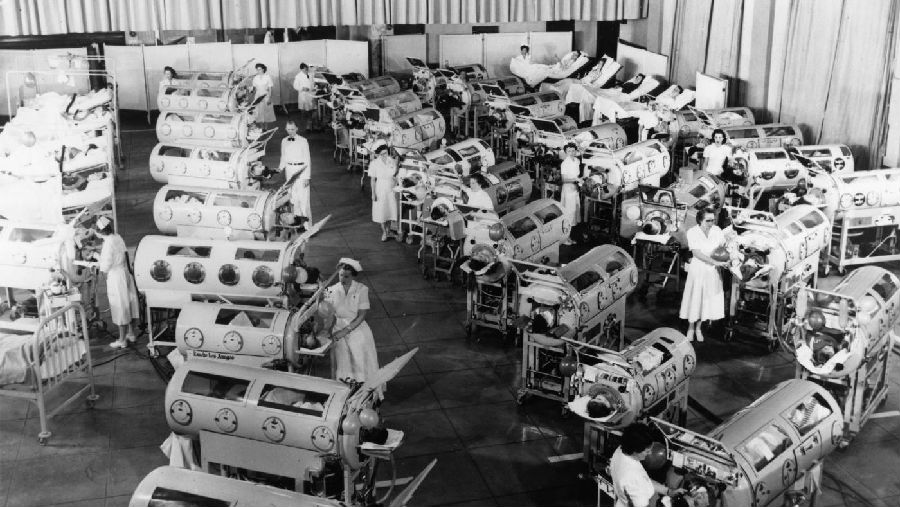Comparisons are more commonly drawn between the 1918 flu pandemic and today,
人們常將當下的新冠肺炎大流行和1918年(西班牙)流感大流行相提并論,
but the polio outbreak is actually the more apt one.
殊不知,更恰當的類比對象其實是脊髓灰質炎(俗稱小兒麻痹癥)大流行。
Today, we hear nonsense about injecting disinfectant into the body to battle coronavirus.
最近,我們聽到了類似向體內注射消毒劑的方式就能對抗新冠病毒這樣的無稽之談。
Back then, it was hanging mothballs around your child’s neck to prevent the scourge popularly known as infantile paralysis.
而脊髓灰質炎大流行期間流傳的無稽之談則是在孩子脖子上掛樟腦丸就能預防俗稱“小兒麻痹癥”的脊髓灰質炎病。
Today, there’s the hyping of the malaria drug hydroxychloroquine to battle a disease it was not meant to battle.
最近被大肆炒作的是治療瘧疾的羥氯喹,問題是,這種藥根本就不是拿來治療新冠肺炎這種疾病的藥。
Back then, it was mixing a paste made of wintergreen, Russian thyme,
而脊髓灰質炎大流行期間被大肆炒作的則是用冬青葉和俄羅斯百里香制成的漿糊
and the oils of rosemary, cajeput and wood—and rubbing them into the muscles.
混和迷迭香、白千層和木材的汁液制成的東西——具體用法則是將其揉搓進肌肉里。
If you think sheltering in place in your climate-controlled, wi-fi-streaming, cable-equipped home seems tough,
如果你覺得宅在風吹不著雨淋不到,無線覆蓋還有有線電視可看的家里躲病毒不夠舒服,
try doing it in a blistering summer before there was air-conditioning or Internet—or even television.
那你可以試試炎炎夏日,宅在沒有空調,沒有網絡,甚至連電視都沒有的地方躲脊髓灰質炎病毒。
As Mark Twain is said to have said, history does not repeat itself, but it often rhymes,
正如馬克吐溫所說,據傳是他說的,歷史并不會重演,但它隔三差五就會押韻,
and the two epidemics, 104 years apart, are forming a tidy couplet.
新冠肺炎和脊髓灰質炎,期間間隔了104年的兩次大流行,儼然一幅工整的對聯。
New York and other cities shut down then as they have shut down now.
那一次同這一次一樣,紐約等各大城市也封城了。
In the first week of July 1916 alone,
僅1916年7月的第一周,
552 children in New York’s five boroughs were stricken with polio, and more than 1,000 the second week.
紐約五個區就有552名兒童染上小兒麻痹癥,感染人數第二周就已破千。
Even before that feverish fortnight,
然而,早在疫情突飛猛進的半月之前,
the city health commissioner, Haven Emerson (the great-nephew of the poet Ralph Waldo Emerson),
紐約市衛生專員黑文·愛默生(詩人拉爾夫·瓦爾多·愛默生的曾侄子)
made it his business to keep New Yorkers apart.
就已將分散紐約人視為自己的職責。
Children under 16 were not permitted in crowded public places.
不允許16歲以下的兒童前往擁擠的公共場所。

Open-air movies, a new summer attraction, were forbidden.
露天電影,在當時還是剛出現不久的夏日誘惑,被禁止了。
Fourth of July celebrations were canceled.
7月4日(國慶節)的慶祝活動也被取消了。
As COVID-19 might be, polio is a seasonal disease, though the poliovirus prefers the hot months,
脊髓灰質炎是一種季節性疾病,盡管脊髓灰質炎病毒更喜歡炎熱的月份,新冠肺炎可能也是一種季節性疾病,
and SARS-CoV-2, which causes COVID-19, is at least thought to prefer the cool ones.
但引發新冠肺炎的SARS-CoV-2病毒是更喜歡,至少在人們的印象中是更喜歡涼爽的季節的。
Now, as in 1916, the push for a vaccine is thus a cyclical one—
和1916年(紐約市脊髓灰質炎大爆發時)一樣,此次新冠肺炎大爆發后的疫苗研制工作也是一個周期過程,
a race against a viral time bomb set to go off by the calendar.
一場與一枚由病毒催生的,按日歷走的定時炸彈的賽跑。
While the clamor for a vaccine was loud after the polio epidemic of 1916, the wait was long.
盡管1916年脊髓灰質炎疫情爆發后,要求接種疫苗的呼聲很高,等待疫苗到來的時間卻很長。
It was not until the summer of 1935 that there was hope, in the form of two great field trials:
直到1935年夏天,人們才在兩項偉大的現場試驗身上看到了曙光:
one by Dr. Maurice Brodie and Dr. William Park of the New York City department of health
一項是紐約市衛生局的莫里斯·布羅迪醫生和威廉·帕克醫生開展的,
and one by Dr. John Kolmer of Temple University in Philadelphia.
一項是費城坦普爾大學的約翰·科爾默醫生開展的。
譯文由可可原創,僅供學習交流使用,未經許可請勿轉載。











